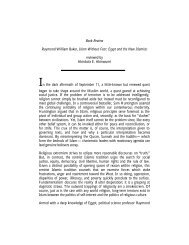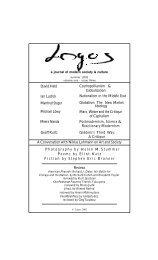Michael J. Thompson Stephen Eric Bronner Wadood Hamad - Logos
Michael J. Thompson Stephen Eric Bronner Wadood Hamad - Logos
Michael J. Thompson Stephen Eric Bronner Wadood Hamad - Logos
Create successful ePaper yourself
Turn your PDF publications into a flip-book with our unique Google optimized e-Paper software.
Abbas Amanat<br />
Even the establishment of the Safavid state (1501-1736) and declaration of<br />
Shi’ism as its official creed (in obvious contrast to the rival Ottoman empire’s<br />
expressed upholding of “orthodox” Sunni Islam) did not substantially alter<br />
the mujtahids resistance to institution development. This in spite of the<br />
Safavid dynasty’s presumed sacred lineage, its active sponsorship of the<br />
clerical establishment and heavy patronage of the teaching circles. The<br />
immigrant jurists from the Arab Shi’ites communities of Jabal ’Amil (in<br />
today’s Syria and Lebanon), Qatif and Bahrain in northern Arabia and the<br />
Persian Gulf, and Najaf and Hilla in southern Iraq were incorporated into<br />
the judiciary of the Safavid Empire. These mujtahids and their Iranian<br />
counterparts, many being converts from Sunnism, considered the Safavid<br />
shahs as legitimate defenders of the faith and their empire as the guarded<br />
Shi’ite domain. For the “learned” (’ulama) community it was therefore<br />
permissible to assume judicial offices, as majority did, collect alms and the so<br />
called the “share of the Imam,” and even to set the congregational Friday<br />
prayer which considered by majority of Shi’ite jurists as impermissible in the<br />
absence of the Imam of the Age.<br />
The jurists’ reluctance in this period to solidify their gains by implementing<br />
a judicial leadership independent from the state is not surprising. Their<br />
reluctance to better define the boundaries of ijtihad was in part because the<br />
Safavid rulers’ successfully recruited the mujtahids as state functionaries.<br />
Although the office of shaykh al-Islam was held by a high-ranking jurist, this<br />
was not understood to be a legal supervision over the entire judicial<br />
community. Nor did it mean administrative or financial control, a task that<br />
the Safavid state consistently conferred on a non-clerical bureaucrat with the<br />
title of sadr (i.e., the chielf officer). Moreover, the Safavids in the late 17 th<br />
century did not hesitate to patronize the alternative Akhbari school which in<br />
contradistinction to the Usuli school rejected ijtihad and its logical<br />
rationalization. The debate between the two schools in the late 17th and<br />
throughout the 18th centuries weakened the development of usul al-fiqh as a<br />
discretionary methodology and favored instead a wholesale and uncritical<br />
validation of all the hadith as sources of the law. More specifically, all reports<br />
(akhbar) from diverse Shi’ite hadith sources attributed to the Prophet and the<br />
Imams, were considered as authentic, with little discretion for their historical<br />
validity. The Akhbari resistance to independent reasoning was congruent<br />
with the Safavid state’s aversion to allow the emergence of an independent<br />
mujtahid-dominated judiciary.<br />
<strong>Logos</strong> 2.3 – Summer 2003




